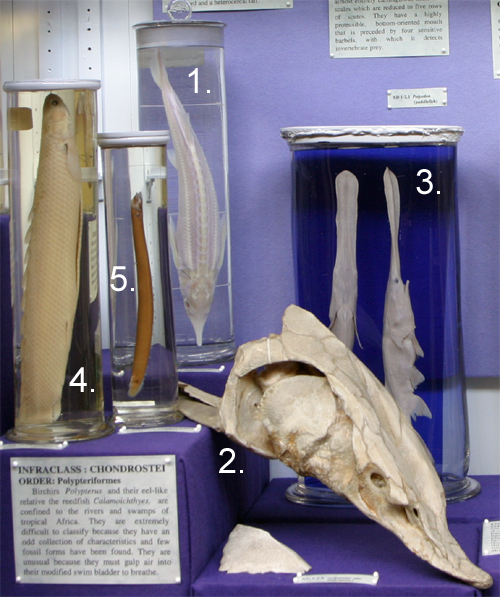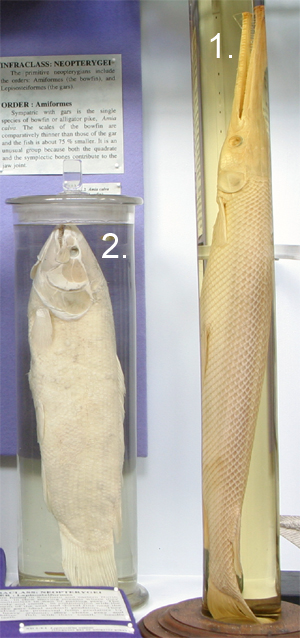
SUBCLASS ACTINOPTERYGII: RELICT SPECIES OF RAY-FINNED FISH & ORIGIN OF TELEOSTS
The living ray-finned fish (subclass Actinopterygii) are the dominant fish today, with 42 orders, 431 families and 23,000+ species, assigned to two infraclasses: the Chondrostei and Neopterygi. All thirty eight species of chondrosteans - sturgeons, paddlefish, birchirs and reedfish - are relict or anachronistic species related to early fish that dominated the Devonian seas. The 23,000+ species of neopterygians includes only eight relict species – the gars and the bowfin; the remaining thousands of species are teleosts. The teleosts are believed to have arisen some 360 mya from a fossil chondrostean, such as Elonichthys, that was related to sturgeons and paddlefish.
INFRACLASS CHONDROSTEI: STURGEONS, PADDLEFISH, BICHIRS AND REEDFISH
The first line of fish to come off the actinopterygian stock were the chondrosteans. Members of both modern orders: Acipenseriformes and Polypterifomes have a series of primitive characters: a largely cartilaginous skeleton reflected in their name, a persistent notochord and a heterocercal tail. They are survivors of the Upper Cretaceous Period (100 - 135 mya).

ORDER ACIPENSERIFORMES: STURGEONS, PADDLEFISH1. Acipenser sp., young sturgeon. Sturgeons (26 species) lack scales except for five rows of bony scutes representing the remnants of ganoid scales. Sturgeons have a highly protusible bottom-orientated mouth, in front of which are four sensitive barbels for detecting prey. They are bottom feeders, when young they feed on benthic invertebrates, but fish become more important components of their diet as they age and grow. Sturgeons are the largest fresh-water fish - the Beluga sturgeon reaches 8.5 metres and weighs 1300 kg.
2. Dried skull and a scute of a sturgeon.
3. Polydon spatula, two young paddlefish. Paddlefish (2 species) possess a long paddle shaped snout, apparently used to detect patches of prey by electrical fields. Their bodies are smooth and scaleless. Polydon spatula occurs in the Mississippi River (U.S.A) feeding on zooplankton scooped out of the water by their gaping mouths and reaching 2 metres in length. Psephurus gladius lives in the Yangtse River (China) apparently feeding on fish and reaching more than 5 metres.
ORDER POLYPTERIFORMES: BIRCHIRS, REEDFISH
The ten species of birchirs and reedfish are confined to the rivers and swamps of tropical Africa - in the Zaire River basin and lakes and rivers of West Africa and Ethiopia. They normally respire through gills but can breathe air when the oxygen content of the water is low; their larvae possess external gills to adapt to low oxygen levels. They feed on fish and invertebrates and may reach 1 metre though most are shorter. They are extremely difficult to classify because they have an odd collection of characters and few fossil forms have been found.
4. Polypterus sp., bichir.
5. Erpetoichthys calabaricus, reedfish.
INFRACLASS NEOPTERYGII: BOWFINS, GARS AND TELEOSTS
The neopterygians were the second major group to emerge from the early ray-finned stock and today include the vast majority of modern bony fish.
They are divided into three Divisions:
Division 1. Order Lepisosteiformes – the relict gars.
Division 2. Order Amiformes - the relict bowfins.
Division 3. Division Teleostei - the 35-38 orders of modern teleosts.
The interrelations between the gars, bowfins and teleosts is unclear and the teleosts are believed to have arisen some 360 mya from a fossil chondrostean, such as Elonichthys (Order Paelaeoniformes), related to sturgeons and paddlefish.

ORDER LEPISOSTEIFORMES: THE GARSThe seven species of gars are found in Southern and Eastern North America, mostly confined to the Mississippi drainage system in slow moving streams where they hang motionless and wait for passing prey. There are two genera; species of Lepisosteus in North America may reach 1 – 2 metres; Atractosteus spatula in Central America and Southern U.S.A. may reach 3 metres.
The long body and snout, plus the placement of the anal and dorsal fins near the tail make gars ideal ambush predators. They chase their prey and immobilize fish with their small, needle sharp teeth. Gars have large swim-bladders which makes them buoyant in spite of their heavy armour.
They themselves are protected from predators by their heavy armour of hard, non- overlapping diamond shaped ganoid scales. They are not obligate air breathers but become increasingly dependent on the lung for oxygen as the water temperature increases and the level of oxygen dissolved in the water falls.
1. Lepisosteus osseus, longnose gar.
ORDER AMIFORMES: THE BOWFIN
Now confined to the Mississippi drainage system, the bowfin, Amia calva, is the only living relict of a group of primitive bony fishes that was once widespread and co-existed with the dinosaurs in the Jurassic period (135 -195 mya). Its name refers to the long undulating dorsal fin. The cycloid scales of the bowfin are thinner than those of the gar and the fish is about 75% smaller; most reach 45 – 60 cm. Bowfins are not obligate air breathers but once the water temperature exceeds 10°C, the lung is used to supplement the oxygen obtained through the gills. Bowfins can survive periods of drought by lying torpid in muddy burrows and breathing air.
2. Amia calva, bowfin.






